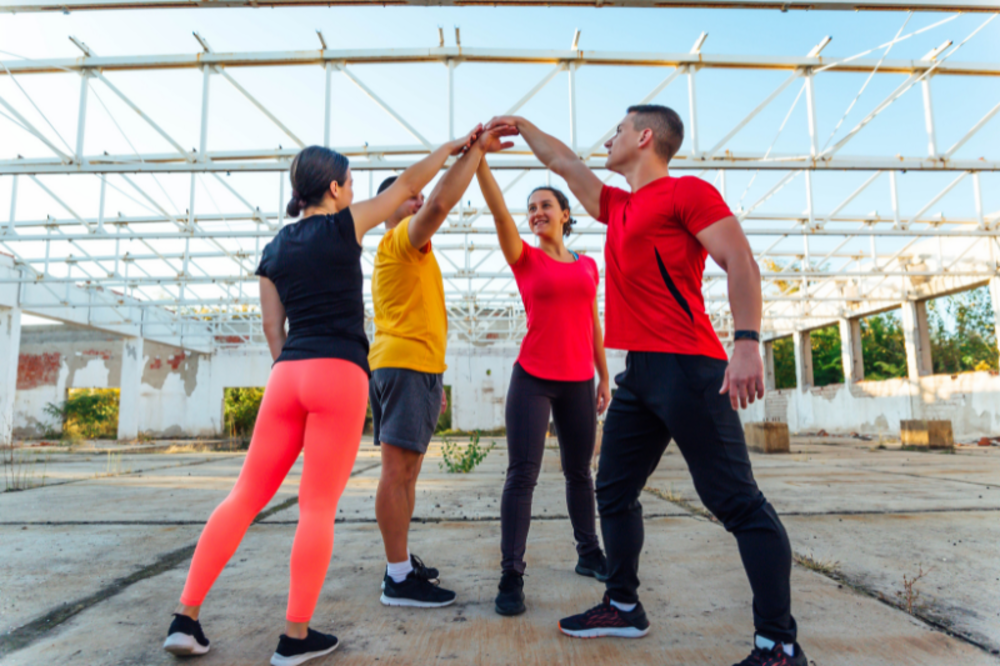Unwanted comments, intrusive staring, and even stalking; these are uncomfortable and disturbing experiences in the fitness industry. While you want to peacefully carry out your exercise routine, the atmosphere is disrupted by such behavior.
Gyms recognize the importance of addressing this issue and are working on a centralized reporting system for unwanted behavior.
Together with the National Athletic Trainers’ Association (NATA) , the Department of Health and Human Services, and the trade association for recognized sports and exercise companies (IHRSA - International Health, Racquet & Sportsclub Association) strive for a safe and respectful sports environment for everyone.
In this blog, we focus on sharing valuable insights and recommendations from reputable organizations regarding the recognition and prevention of inappropriate behavior in gyms and fitness clubs.
Our goal is to collectively raise awareness and contribute to a safe and respectful sports environment for everyone. Let’s acquire knowledge together to effectively address and prevent unwanted behavior.
What is Inappropriate Behavior?
In this section, we explain the definition of inappropriate behavior and discuss its various forms.
Inappropriate behavior occurs when one party does not consent to expressions or actions from another party.
In cases of inappropriate behavior, someone causes harm to another person physically, mentally, or emotionally. This can manifest as sexual harassment or even sexual abuse, bullying, discrimination, or aggression.
Different Forms of Inappropriate Behavior
Sexual inappropriate behavior is an overarching term for various forms of behavior that are often interchangeably referred to misconduct, such as:
Sexual violence
This is defined in the law as assault and rape, involving penetration (rape) or other sexual acts (assault) where force is used, threatened, or advantage is taken of a situation or condition that makes someone unable to refuse.
Child sexual abuse
When an adult abuses a child, there is an imbalance of power, an age difference, or a power differential.
Sexual harassment
This includes verbal, non-verbal, or physical behavior with a sexual connotation that aims to or results in the degradation of a person’s dignity, particularly when it creates a threatening, hostile, insulting, humiliating, or offensive situation.
These are just a few examples, but it can manifest in other ways as well.
Different Forms of Sexual Harassment

As a fitness professional, it is crucial to recognize and prevent sexual harassment in order to ensure a safe and inclusive environment for all members.
The following are the three categories of sexual harassment: unwanted verbal, non-verbal, and physical intimidation and abuse.
Verbal intimidation
Verbal intimidation can take the form of inappropriate comments, intimate questions about someone’s personal life, or unsolicited sharing of sexually suggestive experiences.
This can also occur in the form of persistent requests to exercise together or meet outside the gym, despite clear signals of disinterest.
Sending sexually suggestive messages via social media or other communication channels also falls under verbal intimidation.
Non-verbal intimidation
Non-verbal intimidation can occur in the form of sexually suggestive gestures, displaying explicit images, or prolonged and intrusive staring at someone. Such behavior can create an uncomfortable and unsafe atmosphere in the gym.
Examples include:
- Secretly filming in changing rooms
- Taking explicit photos of other athletes
Physical contact
Unwanted physical contact can range from unsolicited physical behavior, unwanted touching, squeezing, or stroking to attempts to kiss or engage in other sexual acts.
Examples include:
- A hand going too low while providing support during a squat
- Inappropriately touching someone’s chest while correcting posture during an exercise
- Giving a massage in an inappropriate area.
Highlighting the Importance of Transparency: Sexual Harassment Statistics

Sexual harassment remains a serious and widespread problem in the United States. Research by the U.S. Equal Employment Opportunity Commission (EEOC) shows that nearly one-third of the approximately 90,000 charges received by EEOC in recent years include an allegation of workplace harassment.
This research indicates that both men and women are affected by this issue, although women are more often victims of sexual harassment.
For instance, according to the NSVRC 38% of all women and 14% of men have reported experiencing sexual harassment at work.
Additionally, the National Sexual Violence Resource Center reports that one in three women and one in six men in the United States experience some form of contact sexual violence in their lifetime.
A study by Stop Street Harassment found that among over 2,000 American adults, 81% of women and 43% of men reported experiencing some form of sexual harassment or assault in their lifetime. This includes locations like the street, public transportation, or during sports.
In response to these concerning statistics, this blog discusses the emerging trend of gyms specifically for women.
Sexual Harassment in the World of Sports
In recent years, the sports sector has increasingly focused on preventing sexual harassment and abuse of power.
This is partly due to various serious reports, which led to extensive investigations into misconduct in the world of sports.
Such incidents have resulted in adjustments to sports disciplinary law and the way reports of sexual harassment and abuse are handled.
Some important changes in sports disciplinary law include the removal of the statute of limitations, the introduction of a reporting obligation, the improvement of reporting and follow-up procedures, and seeking media attention for this issue on a regular basis.
These measures aim to create a safe and positive sports environment and to take effective action when there is inappropriate behavior in sports.
Statistics on Inappropriate Behavior in Sports
Research shows that nearly half of adults in the United States have experienced psychological inappropriate behavior in sports at least once, according to a survey by the National Alliance for Youth Sports. Additionally, the Centers for Disease Control and Prevention (CDC) notes that approximately 10% have experienced unwanted physical behavior.
The U.S. Center for SafeSport data suggests that about 12% have experienced sexual inappropriate behavior. The figures on sexual harassment in sports demonstrate that many people are affected by it. However, these numbers may actually be higher.
The U.S. Center for SafeSport reports that 90% of sexual inappropriate behavior goes unreported. This could be due to fear, shame, or lack of trust in the system. Therefore, it is important to continue addressing this issue.
Shared Responsibility for a Safe and Respectful Sports Environment

As fitness professionals and athletes, we have a shared responsibility to contribute to a safe and respectful sports environment.
This means not only taking preventive measures but also recognizing signs and providing support to victims.
By increasing awareness and working together, we can combat boundary-crossing behavior in the sports sector and ensure an environment where everyone feels safe and respected.
What Can You Do If You Witness Inappropriate Behavior?
Below is a list that provides various ways to respond:
Involve others
Approach a responsible person, such as a trainer or coach, and involve other people. In case of emergency, call 911 to contact the police.
Distract
Directly address the person being harassed and ignore the perpetrator. Do not talk about the harassment, but discuss another topic instead.
For example, ask a question about the exercise or inquire about the time, pretend to know the person being harassed, or create “accidental” commotion by spilling your water bottle or dropping something.
Address the perpetrator
Remain calm and do not put yourself unnecessarily in danger. If you notice that the victim is being sexually harassed, first reassure them through eye contact.
If the situation allows, address the perpetrator and make it clear that this behavior is inappropriate and disruptive. If you choose to directly address the perpetrator, you can use the following phrases:
- “Your behavior is unacceptable/disrespectful/not okay/…”
- “It’s clear that the person you’re targeting doesn’t appreciate what you’re doing, stop it.”
Keep it brief and do not engage in a debate with the perpetrator. Instead, focus on the person being harassed.
Wait and see
Afterward, you can have a conversation with the person who was harassed. Ask how they are doing and express your concern for what they have experienced.
Inquire if there is anything you can do and offer to wait with them until the danger is gone, while encouraging the victim to file a complaint. Respect the victim’s decision whether or not to do so.
No one is encouraged to take risks for themselves or the victim or to resolve a situation through violence. In cases of aggression or violence, it is best to immediately contact emergency services by dialing the emergency number 911.
What Can You Do If You Are a Victim of Sexual Harassment or Inappropriate Behavior?

If you are a victim of inappropriate behavior, know that you should not feel ashamed, and you are not at fault.
There are several steps you can take to seek help and support:
Talk about it
Reach out to someone you trust, such as a friend, family member, or colleague, and share your experience. Expressing your feelings and thoughts can help in processing the situation.
Seek professional help
Consider contacting a counselor or therapist who has experience in treating victims of sexual harassment and inappropriate behavior.
Report the incident
Depending on the situation and severity of the incident, you may consider filing a report with the police. They can inform you about the necessary procedures and any legal steps involved.
Contact The National Center for Victims of Crime US
This organization provides practical, emotional, and legal support to victims of crimes, including sexual harassment and inappropriate behavior. You can find more information on their website and reach out to them for assistance.
Take care of yourself
Remember to take good care of yourself and pay attention to your mental and physical well-being. This may involve getting enough rest, eating healthy, and engaging in regular exercise.
Remember that you are not alone, and there is help and support available. The most important thing is to take action and ensure you receive the help you need to process and overcome this difficult experience.
Addressing Inappropriate Behavior: A Plan for the Fitness Industry

Below is a step-by-step plan, based on information from the U.S. Equal Employment Opportunity Commission (EEOC) and various human rights groups to effectively address sexual harassment and inappropriate behavior within the fitness industry:
Understand the Laws and Guidelines
Learn about the existing human rights laws, both federal and state-level, that deal with sexual harassment, such as Title VII of the Civil Rights Act of 1964. Review any available guidelines from the U.S. Equal Employment Opportunity Commission (EEOC) and human rights organizations.
Establish Clear Policies
Write comprehensive policies that prohibit sexual harassment and other types of inappropriate behavior. This policy should clearly define what constitutes sexual harassment and should be written in plain language that everyone can understand.
Create a Code of Conduct
In addition to the sexual harassment policy, a broader code of conduct should be created. This code should explicitly state acceptable and unacceptable behavior within the fitness center. This code should also state that all members and staff are expected to treat each other with dignity and respect.
Provide Training
Once the policies are in place, training sessions should be organized for all staff members and contractors. This training should cover the policies, how to recognize sexual harassment, and what to do if they witness or experience it. The training should also emphasize the importance of respect and boundaries.
Establish Reporting Mechanisms
A clear, confidential, and accessible reporting system should be established. People who experience or witness harassment should feel safe to report without fear of retribution.
Investigate Claims Promptly and Thoroughly
When a claim is made, it should be taken seriously and investigated promptly. An impartial party should conduct the investigation to ensure fairness.
Take Decisive Action
If the investigation finds that harassment has occurred, take decisive action. This could include terminating the offender, providing additional training, or implementing other sanctions as outlined in your policy.
Periodic Review and Updates
Policies and procedures should be reviewed periodically to ensure they are effective. It’s also important to stay current with any changes in laws and guidelines.
Ensure Inclusivity and Diversity
A diverse and inclusive environment can help foster respect among staff and customers. Make sure your hiring practices promote diversity, and be aware of and address any microaggressions or bias that may arise.
Promote a Healthy Culture
Encourage a culture where everyone feels safe and valued. Communicate regularly about the importance of respect, boundaries, and the procedures for reporting and dealing with harassment.
How to Handle Reports and Complaints of Inappropriate Behavior

- Encourage Reporting: Promote an open atmosphere for reporting incidents.
- Ensure Confidentiality: All reports must be handled confidentially.
- Take All Reports Seriously: Treat each report with seriousness and respect.
- Investigate Promptly: Quickly begin an impartial investigation.
- Document Everything: Maintain detailed records of all steps.
- Take Action: If a complaint is validated, act in line with your policies.
- Follow-up: Check in with the complainant to ensure their safety.
- Review and Improve: Regularly assess and refine your process.
Remember, it’s crucial that your organization is committed to creating a safe and respectful environment. This is an ongoing process that requires constant effort and attention.
How to Implement Consequences and Provide Support for Inappropriate Behavior
- Take disciplinary action against the perpetrator in line with the seriousness of the offense. This may involve warnings, suspensions, or termination of membership or employment.
- Provide support to the victim, ensuring they have access to appropriate counseling, therapy, or other necessary resources.
- Communicate the outcomes of the investigation and actions taken to all relevant parties involved, within the boundaries of privacy and confidentiality.
- Review and evaluate the effectiveness of your policies and procedures on a regular basis. Make adjustments as necessary to continuously improve your organization’s approach to preventing and addressing sexual harassment and inappropriate behavior.
By following these steps, fitness professionals can contribute to creating a safe and respectful sports environment, where innapropiate behavior is effectively addressed and prevented.
Final Thoughts
Addressing inappropriate behavior, including sexual harassment, in the fitness industry is crucial for creating a safe and inclusive environment for all members.
By understanding the different forms of boundary-crossing behavior and implementing preventive measures, fitness professionals can play an active role in preventing and addressing these issues.
It is essential to have clear policies and procedures in place, provide training to staff, and establish mechanisms for reporting and handling complaints. Supporting victims and implementing consequences for perpetrators are also critical steps in creating a safe and respectful sports environment.
Remember, no one should experience harassment or inappropriate behavior in any setting, including fitness facilities. Together, we can work towards a culture of respect, empathy, and inclusivity in the fitness industry.




